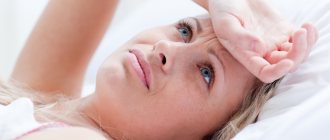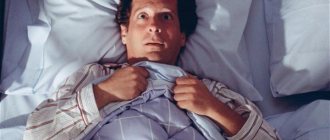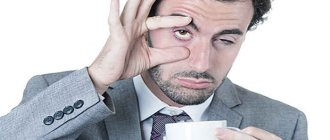Causes
Not long ago, scientists discovered the etiological factors of this disorder.
Narcolepsy develops against the background of metabolic disorders that occur in the brain. Due to a deficiency of the neurotransmitter orexinau, a person experiences attacks of a wild desire to sleep.
The lack of this substance in the body is caused by the following reasons:
- TBI;
- Hormone failure;
- genetic predisposition;
- psychological diseases;
- diabetes;
- severe nervous tension;
- diabetes;
- infectious brain diseases.
The exact causes and mechanism of development of the pathology are still being studied by specialists.
Due to a deficiency of the neurotransmitter orexin, a person experiences attacks of a wild desire to sleep.
- frequent stressful situations;
- drug and alcohol abuse;
- chronic fatigue;
- previous brain surgery;
- taking antidepressants;
- violation of the day and night routine.
Why do you sleep on the go?
No one likes to feel like a “sleepy fly,” because every person wants to be active and work productively. To fix the problem, you need to answer the question: “Why do I sleep on the go?” The reasons may be as follows:
- Breathing disturbances during sleep. If a person is out of breath or snoring, they will wake up feeling tired and groggy.
- Uncomfortable conditions (uncomfortable bed, stale air in the room, incorrect air temperature in the room). As a result, a person does not get proper rest.
- Taking sleeping pills often leads to drowsiness, since the effect of most of them lasts more than 6 hours. Thus, the human body is awake, but the brain still continues to sleep.
- Chronic fatigue associated with low hemoglobin levels, hypovitaminosis and oxygen starvation.
- A sedentary lifestyle is accompanied by the accumulation of lactic acid in the muscles, which causes a sleepy state.
Increased sleepiness is not always a consequence of overwork or irrational organization of the work process. Sometimes this can be a symptom of serious illnesses. Here are the most common ones:
- Heart failure causes oxygen starvation of the cerebral cortex. As a result, a person feels constant fatigue and suffers from sleep disturbances.
- Encephalopathy is the culprit of increased activity, which alternates with severe inhibition of the cerebral cortex. One of the signs of the disease is a constant need for sleep.
- Kidney pathologies often cause retention of nitrogenous waste in the blood. This leads to the fact that a person sleeps for an abnormally long time, and during the waking period he is tired and passive.
- Liver pathologies make it difficult to cleanse the blood of metabolic products. As a result, a large amount of toxic substances begin to enter the brain. Also, such conditions cause the synthesis of serotonin, lactic and pyruvic acids, which leads to a deterioration in blood supply to the brain. This not only leads to constant drowsiness, but can also cause coma.
- Infectious intoxication is associated with infection of the body by bacteria, viruses, fungi and parasites. This leads to weakened immunity, which is accompanied by pathological drowsiness.
- Hypothyroidism is a lesion of the endocrine glands, the main symptoms of which are lack of emotion, loss of interest in life, and constant drowsiness. This condition is caused by a drop in the levels of hormones produced by the thyroid gland. As a result, there is oxygen starvation of the brain and excessive accumulation of fluid in its convolutions.
- Hypocortisolism is adrenal insufficiency. This condition is accompanied by a decrease in blood pressure, which certainly causes drowsiness.
- Diabetes mellitus creates all the conditions for carbohydrate imbalance. Constant fluctuations in insulin and blood sugar levels lead to damage to the cerebral cortex, which can cause encephalopathy. Daytime sleepiness is one of the main signs of this problem.
- Brain injuries can cause circulatory problems. As a result, oxygen starvation occurs. In addition, disturbances of consciousness may occur. Drowsiness is one of the most common symptoms accompanying head injuries.
Signs of the disease
There are two mandatory symptoms of narcolepsy:
- Falling asleep “on the go”, when a person suddenly falls asleep for no apparent reason. Most often this happens during monotonous work, but it is possible to completely unexpectedly fall asleep during a conversation, while walking, while watching a movie, or in any other situations. Such sleep usually lasts a few minutes, but in severe forms of narcolepsy it can last for hours.
- Sudden involuntary relaxation of all muscles of the body (cataplexy), which occurs at the moment when a person experiences vivid emotions (laughter, surprise, rage, vivid memories, anxiety, a certain period of sexual intercourse). Cataplexy (loss of muscle tone) is rarely the first symptom of narcolepsy, and much more often it develops over the years.
In the first case, inhibition captures the cerebral cortex, but does not reach the lower parts of the brain, so the person falls asleep, but immobility does not occur. So, if he falls asleep while walking, then in a sleeping state he can walk for another 1-2 minutes and then wake up.
In the second case, the opposite happens. With normally preserved consciousness, immobility occurs. The person’s muscles relax, he simply falls, but still manages to find a place to fall, for example, sits down on a chair.
These are not all the symptoms of narcolepsy; many patients experience the full range of possible symptoms, including:
- sudden falling asleep and cataplexy (discussed above);
- vivid dreams up to hallucinations that are observed when falling asleep or waking up;
- immediately after waking up, a person cannot move for several seconds (this condition is called sleep paralysis);
- there is an urgent need for daytime sleep.
In addition, due to the absence of the slow-wave (deep) sleep phase, it is not uncommon for patients with narcolepsy to sleep poorly at night, their sleep is shallow, and they often wake up.
Symptoms of narcolepsy can develop over many years or occur all at once. However, you should not assume that if you have the symptoms listed above, then you necessarily have narcolepsy. These manifestations are also signs of many other diseases, but most often they can simply be temporary disorders due to stress, chronic fatigue, lack of sleep, etc.
How to detect the disease and which doctor to go to
Narcolepsy is a very serious disease, dangerous due to its manifestations, in particular, unexpected falling asleep. The patient must be observed by a doctor, helping to control sleep attacks, adjusting dosages of drugs to avoid addiction and side effects.
It should be noted that the life of narcoleptics greatly depends on the manifestation of the disease, we are talking about both its quality and duration. Patients definitely cannot choose professions that require increased attention and concentration; they should not drive vehicles or machinery. It is advisable to give up bad habits - there is evidence that they worsen the course of the pathology.
Do not hide your diagnosis from family and friends - this will help maintain important social connections. If your relative suffers from narcolepsy, be understanding.
When planning a family, take into account the fact that narcolepsy has a genetic predisposition.
Drugs used to treat this disease may affect the result of the drug test; to avoid unpleasant situations, inform us in advance about your diagnosis and the therapy used.
First, you should do an analysis of the complaints with which you go to the doctor. They can be of the following nature:
- Duration of the disease: when it appeared, and what signs were the first.
- Heredity: did anyone in the family suffer from a similar illness.
- The presence of severe traumatic brain injuries, severe infectious diseases.
- Medicines you are using.
- The presence of allergic reactions to any drugs or products.
A neurologist examines patients with signs of narcolepsy.
To detect this pathology, polysomnography is performed with recording of an electroencephalogram and a multiple sleep latency test.
For a more accurate sleep analysis using specialized somnological laboratory procedures, you need to undergo an examination by a somnologist.
You should also undergo computed tomography and magnetic resonance imaging. This will allow us to study the structure of the brain more deeply and eliminate the possibility of damage to the areas of the brain responsible for sleep and wakefulness.
Diagnostics
When diagnosing, the primary role is played by complaints and a description of the patient’s behavior. But for a detailed study, studies using instrumental equipment are prescribed.
To identify this type of disorder, use:
- Polysomnography is an instrumental type of patient examination. It is carried out during sleep. Records heart, breathing and brain activity. The intensity of muscle contractions and myoclonus of the limbs are read;
- multiple sleep latency test (MSLT). It is carried out during daytime sleep. Determines in what period of time the patient falls asleep and what stages of sleep occur.
A brain tomography may be prescribed. It will allow us to study the brain in more detail and identify damaged areas, if any.
Drowsiness after eating
Unfortunately, narcolepsy is an incurable disease. At least at this stage of medical development.
Gelineau's disease affects different areas of a person's life and a huge number of organs of his body:
- Narcolepsy primarily affects physical well-being and safety. The most ordinary activities can become life-threatening: driving, cleaning, cooking and many other processes can be fatal.
- Mental health also suffers. The disease can destroy a person’s life, especially if he was very active and enjoyed extreme sports, and lead to severe depression.
- Social and professional relationships. With Gelineau's disease, you are unlikely to be hired, and old acquaintances may not be such good friends as you previously thought, and they will leave you. Indeed, few people would want to accept sudden sleep and fatigue as a given.
- Intimate relationships with narcolepsy are also at risk. Extreme sleepiness can lead to impotence.
- Memory and attention. The disease will take its toll on memory. It will be difficult for you to concentrate on any things, and huge gaps will form in your memory.
Sometimes a person sleeps on the move after eating. This symptom becomes especially pronounced in the afternoon. However, there is nothing abnormal about this that would cause concern. When food enters the gastrointestinal tract, the organs begin to work harder, and the largest volume of blood flows to the digestive system.
Results
Narcolepsy is a pathology that is characterized by the onset of sleep (namely, its rapid phase) suddenly and unexpectedly during wakefulness. In this case, the narcoleptic can “switch off” at any time and anywhere for a period from several minutes to three hours.
The disease is currently incurable; attacks of narcolepsy can be made minimally frequent with the help of special therapy.
The course of the disease is beneficially influenced by the normalization of night rest and the organization of a daily routine, but despite this, patients with narcolepsy will have to control their peculiarity for life, suffering somewhat from restrictions in the choice of profession, entertainment, and sometimes even taking specific medications.
What is narcolepsy
Narcolepsy is a pathological condition of the nervous system of a neuralgic nature. This pathology is also called Gelineau's disease. It should not be confused with psycho-emotional disorders.
Refers to hypersomnia, and is characterized by increased daytime sleepiness, which cannot be avoided.
The violation is dangerous because sleep can occur at any moment - during work, while driving a car, on the street.
Narcolepsy syndrome is a rare disease that occurs in a young percentage of the population. It most often manifests itself in people aged 15-30 years. It is very rare in women and children.
How does an attack proceed?
The essence of the pathology lies in spontaneous daytime falling asleep. There is a strong desire to fall asleep that is impossible to cope with.
Any ways to cheer yourself up become ineffective. Exercise, washing, smoking, patting yourself on the cheeks only bring you to your senses for a short time. The patient “switches off” in different places and in different positions.
A sudden dream can last either half an hour or a second.
Usually a narcoleptic person wakes up on his own and feels a surge of strength and energy.
After a short time, the attack resumes again. During an important meeting, driving a car, even during an emotional conversation.
This behavior occurs many times a day and can be life-threatening for the patient and those around him.
Situations are possible when a person, arriving in a state of sleep, does not stop his actions.
For example, a person sleeping while driving continues to drive the car. At the same time, nacroleptics understand that they were sleeping, but they cannot do anything.
There is another type of narcolepsy - cataplexy.
In this attack state, muscle tone is lost. The patient loses the ability to move and speak.
Often aimed at a separate muscle group, then only certain parts of the body lose activity - legs bend, arms sag, head falls. At the same time, understanding is not lost; the narcoleptic is aware of what is happening to him.
This lasts for several seconds, sometimes repeated many times, almost without interruption.
A third of patients suffering from this illness have hallucinations. They can be gustatory, auditory, visual and even tactile.
How to awaken the body?
A person who gets up early every day constantly says about himself: “I sleep on the go.” To feel energized and have a productive day, use these tips:
- Open all curtains to let plenty of light into the room. If it's cloudy outside, provide good artificial lighting.
- Lack of fluid in the body leads to loss of strength. Drink as much water as possible throughout the day if you want to feel energized.
- Always have breakfast, because food helps the body wake up. Your diet should contain as much protein as possible.
- Move more. If you have a sedentary job, roll your neck in different directions. And if possible, walk around the office, jump and even do a few squats.
- Learn to breathe with your belly. Take a few quick breaths if you feel sleepy.
- Train yourself to wake up and work to active, rhythmic music. You need to choose tracks that make your body dance on its own.
- To get rid of drowsiness, you need oxygen. Open a window or go outside to breathe in some fresh air.
- Start your morning with a shower (it’s better if it’s contrasting). If you feel sleepy in the middle of the day, just wash your face with cold water.
- If you really want to sleep, it will be useless to fight your body. Give yourself a rest for 15-30 minutes, then start working with renewed vigor.
Hypersomnia is a sign of vitamin deficiency
If a person sleeps a lot at night and during the day, then perhaps he lacks the necessary substances and microelements. This problem can arise due to strict diets. Anorexics suffer from increased sleepiness. The reason is that the body simply does not have the energy to function properly.
Vitamin deficiency causing hypersomnia:
- Cyanocobalamin or B12 is necessary to saturate cells with oxygen. Without air, the body wears out, metabolism slows down, and fatigue sets in;
- Ascorbic acid. With a lack of this element, mental and physical activity decreases, immunity weakens;
- With a deficiency of vitamin A, vision deteriorates, fatigue and weakness appear;
- D. A lack of ergocalciferol and cholecalciferol leads to a person getting tired quickly. You can compensate for the deficiency of this vitamin with regular sunbathing.
General information
All patients suffering from narcolepsy present the same complaints:
- Night sleep disturbance. They are distinguished by polymorphism - frequent awakenings at night, insomnia, vivid, disturbing dreams. After waking up, as a rule, a person feels overwhelmed, tired and sleepy, oddly enough. As a result of poor quality night rest, patients suffer from absent-mindedness, increased drowsiness, and irritability during the day. This leads to disruption of social adaptation, inevitable conflicts, depressive neuroses, and manifestations of chronic fatigue syndrome.
- The main, pathognomonic (characteristic of this disease) symptom is pycnolepsy. This is precisely the “attack” of sleep. Patients with a long history of the disease feel certain signals of imminent sleep (such as sudden fatigue) and can predict the imminent onset of an attack. For beginners, this is a completely uncontrollable process. Essentially, REM sleep occurs while you are awake. The patient can be awakened, and he will feel quite alert, but a rapid re-attack is possible. Sleep lasts from several minutes to three hours and is characterized by all the properties of ordinary rest - minimizing psycho-emotional reactions, reducing reactogenicity in relation to the outside world. Attacks become more frequent during monotonous life activities - listening to tedious lectures, watching TV shows, but can even occur during a game of volleyball, for example. Daytime falling asleep may be accompanied by threatening dreams, similar to hallucinations.
- ¾ of patients suffer, along with narcolepsy, from cataplexy - attacks of sudden muscle weakness, generalized or local. These attacks correspond to the patient's condition - a disorder of normal speech, the inability to move a part of the body, or a complete temporary loss of motor ability. Often such attacks are triggered by strong emotions - euphoria, anger, ecstasy.
- One-quarter of narcoleptics also experience sleep paralysis. These are also attacks of generalized (general) muscle weakness, which occurs when falling asleep or waking up; it is accompanied by panic attacks, an overwhelming feeling of fear in a person. Studies have shown that during sleep paralysis, the state of the muscular system is completely identical to that during the rapid phase of sleep.
You just need to lead a healthy lifestyle. For narcolepsy, treatment is supportive and lifelong. It is important for the patient to reconsider certain moments of life, eliminate stress from life or adapt to unfavorable moments in his life. Necessary:
- eliminate alcohol intake;
- stop smoking;
- avoid eating fatty foods;
- to live an active lifestyle.
Patients are required to go to bed at the same time. You should not watch or read films and books at night that cause a surge of emotions or fear. Going to bed should take place in a calm, quiet environment. You should not turn on bright lights or listen to loud and nerve-stimulating music. During the day, it is also important to protect yourself from stress and negative emotions.
It is recommended to go to bed during the day - it is important to maintain a sleep and rest schedule. Daytime sleep should be shorter than nighttime sleep. People suffering from narcolepsy are advised to take a daily nap for 30-40 minutes. After such a short rest, the patient again feels cheerful and full of energy.
Sleeping while sitting at the table
To ensure that sleeping at your desk brings maximum benefits, it is recommended that you lean the back of your chair back a little before falling asleep. The tilt angle should be 40 degrees. It is better if you can place something soft under your lower back, such as a pillow, blanket or special pad. It will serve as a support for your back. Place a small pillow under your neck, your head will be tilted back, and you will fall asleep faster.
After this, cover yourself with a blanket. It’s better if you tuck it under you, so it won’t fall and wake you up. It is recommended to rotate during sleep, this will prevent the muscle fibers from oozing and improve its strength, which is its benefit and strength.
Important! Under no circumstances should you lean on the table. At first glance, it may seem that sleeping with your hands and head on the table is much better and more comfortable. This may indeed be true, but the general well-being and condition of a person after waking up will be very different.
People who study sleep recommend choosing the side of the plane on which you are accustomed to sleeping. Attention also needs to be paid to which side will have more light and sun during the trip. This is explained by the fact that you can’t rest on a hot porthole because you need to.
If the prospect is sitting on one chair, then in order to reduce pressure on the vertebrae while sitting while resting, it is recommended to place a pillow or folded blanket under the lumbar region of the spine.
It is not recommended to rest your head on the back of the chair located in front. This is explained by the fact that you will feel all the movements of your neighbor. Try not to cross your legs when flying, this is harmful because... the risk of venous thrombosis increases.
You can use pillows, blankets and blankets to increase comfort. Clothing should be loose and made from natural fabrics that allow the skin to breathe. You can change into slippers or just take them off.
You can put an inflatable pillow under your head, wear a mask over your eyes, and earplugs or headphones on your ears. You can listen to light, soothing music. As for watching movies, there are conflicting opinions, because the radiation from screens dulls the production of the sleep hormone melatonin. The choice would be to read a book. Please note that the air on the plane is dry, so if you suffer from dry skin, it is recommended to take moisturizing cosmetics with you.
Folk recipes
If you constantly tell yourself: “I sleep on the go,” folk wisdom will tell you what to do. This problem is usually dealt with as follows:
- Avoid soap and other products containing alkali. Getting through the pores, it contributes to fatigue.
- Rinse the oat grains thoroughly (about a glass) and add a liter of water. Cook the mixture until it looks like jelly. Strain, mix in equal proportions with milk and add a little honey. Drink a third of a glass four times a day. To completely solve the problem you need to take a 3-month course.
The story of one famous patient
More recently, historians have discovered that the famous artist Leonardo da Vinci suffered from narcolepsy. According to their conclusions, even as a child he had increased sleepiness, which developed after 3 years spent in the dungeon.
However, the artist learned not only not to pay attention to it, but also to derive certain benefits for himself.
He made a special rocking chair in which he slept during attacks. And after waking up, he immediately took paper and pencil and sketched his dreams.
Interesting Facts
During attacks of narcolepsy, the feeling of sleep exclusively affects the cerebral cortex and does not reach the rest of the brain. Therefore, a person seems to be sleeping, but complete immobility does not occur.
For example, if an attack occurs while walking, then he will continue to walk further in an unconscious state. And when he wakes up, he may not even realize that he “passed out” for a few minutes.
In contrast, some patients experience the complete opposite symptoms. The person is in a conscious state, but his muscles seem to atrophy and stop obeying him.
If an attack occurs while walking, the patient may simply fall. At the same time, he will understand everything, but will not be able to do anything with his body for several minutes.
Currently, scientists are trying their best to find an effective cure for narcolepsy. More recently, American doctors have invented a new drug that almost completely eliminates this disease and have successfully tested it on animals. Therefore, such patients should not despair.
Narcolepsy is a disease of the nervous system that is characterized by a disorder of paradoxical (rapid eye movement) sleep and manifests itself as excessive drowsiness and sudden “attacks” of sleep.
Drug therapy
Modafinil
In many cases, the effective medicine Modafinil or its analogues is used. An effective psychostimulant was developed in the last century by an American pharmaceutical company. It is used to eliminate daytime sleepiness and treat narcolepsy. Take the drug in the morning at a standard dose of 100-200 mg.
The mechanism of action of Modafinil is different from Amphetamine. The components of the drug have a direct effect on specific areas of the brain. Under the influence of the drug, the speed of mental reactions increases. The activation of the neural pathway increases and the effect of the neurotransmitter hypocretin increases. The drug activates the central nervous system and regulates sleep/wakefulness.
If the patient does not respond well to treatment with Modafinil, the drugs Methamphetamine and Methylphenidate are prescribed. The drugs may cause some adverse reactions - increased heart rate, hypertension, agitation. The body may become accustomed to the medicine. If adverse reactions develop, you should inform your doctor.
Indopan
The drug Indopan is a nervous system stimulant. It relieves the manifestations of various psychosomatic diseases, schizophrenia, depression and narcolepsy. The drug eliminates the appearance of hallucinations and sleep disorders. Prescribed in tablets 2-3 times a day. The dosage is determined individually by the doctor depending on the clinical manifestations. The therapeutic course of Indopan lasts from 8 to 12 weeks. The withdrawal of the drug is carried out gradually.
Imipramine
The antidepressant Imipramine has high bioavailability and is prescribed to normalize sleep disorders. The active ingredient of the drug captures neurotransmitter monoamines - serotonin, dopamine, norepinephrine. The adrenergic blocking effect of the drug calms the central nervous system. Side effects may include dizziness and headaches, convulsions, and tremors of the limbs.
Sidnocarb
The drug Sidnocarb is prescribed for sleep disorders, lethargy, apathy, and asthenic disorders. The drug is widely used in eliminating the symptoms of narcolepsy and depression. The drug includes psychostimulants that reduce the uptake of catecholamines and affect certain brain structures.
Sidnocarb is administered orally before meals. For a single use, it is taken in the morning. The reception can also be divided into two times - in the morning and in the evening. The maintenance dosage for narcolepsy is 5-10 mg per day. Sidnocarb is started with a minimum dose of 5 mg. Then the dosage is gradually increased.
If you increasingly begin to tell yourself: “I sleep on the go,” you may need medication to eliminate the unpleasant symptom. Pay attention to these tools:
- Amino acids show good effectiveness in combating drowsiness. You can take “Glycine” or glutamic acid 1-2 tablets per day.
- “Modafinil” is a relatively new substance that is designed to regulate wakefulness and rest without causing harm to the body. Such drugs will be effective even if the increased drowsiness is chronic.
- “Supradin” is a vitamin and mineral complex that charges the body with energy, making a person active and cheerful.
Possible harm
When a child or adult sleeps sitting up for a long period of time (more than one month), it can lead to certain consequences:
- An uncomfortable posture leads to compression of the spinal arteries that supply blood to the brain. This leads to ischemia and disrupts night rest, causing drowsiness and a feeling of weakness after a night's rest;
- significant pressure on the vertebrae as a result of prolonged stay in an uncomfortable position can lead to changes in the spinal column and cause exacerbations of a number of diseases, including osteochondrosis;
Sleeping in an uncomfortable position threatens the development of spinal diseases
- similar consequences that occur in older people can cause ischemic stroke.
To restore the quality of night's rest, it is necessary to contact doctors who can select recommendations and treatment for a person.
In this regard, many doctors talk about the dangers of sleeping in a sitting position, both for adults and children.
Doctors who insist that you should not sleep while sitting give the following recommendations to people with sleep position disorders.
- If the problem is psychological in nature, then the person should contact a psychotherapist who can help in such a situation. Learning to sleep in a new position is also of certain importance, for which there are a number of special techniques. You can get acquainted with them from your attending physician or a somnologist.
If the reason for sleeping in a sitting position is caused by psychological problems, then you need to seek help from a psychotherapist
- It is necessary to ventilate the room before going to bed, use a comfortable mattress, do not overeat in the evening and do not engage in activities that excite the central nervous system.
- If you have diseases that interfere with the process of falling asleep in a lying position, you must contact a medical institution for their treatment. Early detection of diseases allows them to be quickly treated without developing negative health consequences.
Sleeping in a sitting position in a child or adult is associated with the psychological characteristics of a person or with certain diseases. Identifying the causes of this condition allows you to draw up a plan for developing the habit of sleeping while lying down and select recommendations for organizing night rest.
There are situations in our lives when we have to sleep sitting up. Workaholics and students often suffer from this, falling asleep over a vast amount of information, leaving themselves no time to rest. There is also a situation when simply sleeping while sitting is the only available solution, because it is impossible to lie down. Travelers often sin like this, because sometimes you have to spend a sleepless night at the airport and need to take a breather for at least a couple of hours. Naturally, sleeping while sitting is not the best practice, there is no need to talk about harm at all, but how can you make it less painless for the body and as optimal as possible in terms of the amount of restored strength? And why can a correctly chosen posture almost completely replace normal sleep?
Sleeping while sitting can completely restore the physiological need, but in order not to feel burning pain in the joints and neck after such a night, a specific “experience” is required.
Otherwise tomorrow will start with:
- Brokenness.
- Drowsiness. To the point where you sleep an extra couple of hours during the day.
- Poor concentration. It is especially dangerous for drivers and people involved in physical labor.
- Irritability. A person who hasn't had enough sleep gets enraged by everything, you've probably encountered this.
All this makes me wonder whether it would be better to take stimulants (be it caffeine or drugs for narcolepsy) and postpone sleep until later, and what ways are there to fall asleep while sitting?
To begin with, there is a myth that all missed hours of rest can be “made up” - it is completely false. In fact, you can only recover from being awake at night within 48 hours, after which your central nervous system will suffer irreparable damage and will have to spend much more time on its annihilation than the classic 9 hours.
The next common misconception is that “sleeping less than 8-9 hours is harmful,” which is why many people prefer to spend the dark hours at work. Is it possible to sleep only 2-3 hours a day? In fact, yes, if you divide them correctly throughout the entire waking period, there are a hundred techniques for this. And if you only have a couple of hours left, taking into account the trip home and back, it is better to choose this option - the quality of sleep will increase and the psychological factor of the problem of “lack of sleep” will disappear completely in a comfortable environment.
None of these solutions are beneficial for the body (besides breaking up sleep periods), but sometimes there is simply no choice, because we live in an era of lack of time for everyone and everything.
If a person feels that he is falling asleep and is no longer capable of adequately performing the assigned task, what should he do?
The plan is:
Stretched intervertebral discs and other unpleasant consequences will overtake you in any case, but all this minimizes harm to health as much as possible.
Remember, such practice on a regular basis is not just harmful, but detrimental to your health. Once or twice a week will already become an unpleasant experience, if this happens more often, change your daily routine and try to squeeze in proper rest, even if it becomes 5-6 hours of sleep instead of the promised 8, because in fact, for some, this will be enough to restore strength , each body has individual needs, sleep as much as you like, but don’t oversleep.
Someone will say “I sleep like this all the time and the healthiest!”, which will not necessarily be a lie, it’s just that this person’s body has already adapted to such changes.
People in general adapt quite quickly to any conditions, but in this case this is not good, because after two or three weeks of this practice, you will probably notice:
This is only a small part of the consequences of sleeping while sitting and sleepless nights in general, as in an iceberg - all the most dangerous things are hidden under the surface of the water.
A person needs time to rest, and try to allocate it to yourself even in excess, otherwise it will lead to multiple health problems, both psychological and physiological.
Choosing a comfortable position for a night's rest is not easy, and sometimes the decision is made spontaneously and is determined by lifestyle. A person who has been working too long or is tired from work may fall asleep in a sitting position. But is sleeping while sitting harmful or beneficial? The information presented in the article will help you understand this.
Sleeping while lying down is considered physiologically correct, which is determined by the peculiarities of the structure and functioning of the human body. Humans are upright mammals, and when walking while awake, the muscles are under tension, the spine experiences greater load due to atmospheric pressure (in a vertical position, the air column presses much more strongly). Nature has thought out that a person, resting at night, takes a recumbent position: it allows all muscle groups to relax, ensures the restoration of the spine, and reduces the force of gravity affecting the body.
The benefits of sleeping in a sitting position for healthy people who do not have chronic diseases are questionable and contradict the anatomy of the body. In this position, it is difficult to fully relax and fall asleep soundly. On a chair or in an armchair without armrests, the person falling asleep begins to slide and fall, shuddering from his own spontaneous movements. After waking up, you don’t feel the best: you experience weakness, pain in the head, neck, limbs and whole body, and drowsiness. Strength is not fully restored, a person cannot immediately begin everyday activities and get involved in the work process.
The benefits of rest while sitting are noticeable and justified only if it is impossible to sleep in another position. Thus, the need to relax, fall asleep and sleep may arise when traveling on an airplane or on a long bus ride. It is necessary to rest to restore strength and relieve tension. Sitting rest is recommended for people who have to work for a long time and periodically linger at the workplace.
Sitting may cause strange or bad dreams. Do not rush to look into the dream book and find out the interpretation of dreams. Nightmares are often caused by overexcitation of the nervous system, emotions experienced during the day and an uncomfortable position of rest at night.
Drowsiness caused by intoxication
“I constantly sleep on the go” is a common state of people who have bad habits. So, bad habits can have the following effects on your body:
- Alcohol - when the concentration in the blood reaches 2.5 ppm, the stage of excitation begins. This is followed by severe and prolonged drowsiness.
- Nicotine leads to vasospasm, which prevents the required amount of oxygen from reaching the brain. All this is accompanied by inflammation of the membranes of blood vessels, the development of plaques and blood clots. As a result, 30% of smokers experience constant drowsiness.
- Taking psychotropic substances (without a doctor's prescription) leads to the formation of chronic drowsiness. This is due to the fact that the processes occurring in the central nervous system are inhibited. With prolonged and uncontrolled use of drugs, it is impossible to return to normal without medical assistance.
- Drugs act like alcohol, causing agitation followed by extreme drowsiness.
Treatment methods
The disease is completely untreatable. But you can reduce the number of daytime sleep fragments and reduce nighttime activity. Get rid of hallucinations and cataplexy.
Among the medications, psychostimulant drugs have proven themselves, such as:
- Modafinil,
- Sidnokarb,
- Meridil,
- Indopan.
Eliminate daytime sleepiness.
To improve night rest, sleeping pills are prescribed. Although they are ineffective for this kind of disorder.
To get rid of cataplexy and hallucinations, antidepressants are taken.
The disease is still poorly understood and, without medical examination, Gelineau's disease is difficult to prevent. But following generally accepted recommendations, it is possible not to worsen the situation.
- sleep hygiene. Drawing up a schedule and constantly following it will help adjust the body to a certain rhythm and alleviate the patient’s condition;
- physical training. Regular exercise will help improve your health. Just don’t overuse physical activity in the evening; it’s better to move it to the morning or lunch;
- alcohol and caffeine. Avoid drinking alcohol and energy drinks, they only create an imaginary wakefulness in your body;
- stress. Try to avoid stressful situations and scandals at home, which not only spoil your emotional state, but also undermine your health. Treat everything superficially;
- fragmentation of cases. Break important big tasks into small and simple ones with a short period of time. It will be easier for you to concentrate on small tasks.
But the world does not stand still, and in recent decades medicine has been moving forward with great strides.
For example, American scientists have already developed a spray containing orexin, which has already been tested on animals and has shown good results. Perhaps, in a short time, we will be able to obtain an effective medicine against this serious illness.
The disease has not yet been cured radically, but certain achievements have been made in this direction. People with such a deviation do not need to despair. You should reconsider your lifestyle and adapt to the problem. Narcoleptic pathology does not pose a threat to life, if you exclude situations in which falling asleep is risky.
Symptoms
The disease is called young. It appears most often between the ages of 15 and 30 years. And in rare cases up to 50.
The main symptoms include regular sleep attacks every day.
Manifest in the form:
- unexpected drowsiness during the daytime, when a person falls asleep while walking;
- lack of concentration;
- attacks of cataplexy - decreased muscle tone. The ability to move and speak is lost, paralysis occurs;
- fatigue, absent-mindedness;
- accompanied by hallucinations.
Seizures can occur spontaneously or against the background of emotional states. And not only negative ones, but also positive ones - laughter, anger, fear, sexual intercourse.
Why does a person fall asleep while walking?
The human brain is responsible for sleep, its normal course and deviations; the causes of problems must be looked for there. Recent research by scientists has shown that sleep disorders occur due to a lack of orexin. Orexin or hypocretin is a brain neurotransmitter that is responsible for wakefulness. In people suffering from this disease, orexin is found in reduced amounts in the cerebrospinal fluid. For what reasons its production decreases is unknown.
Hereditary predisposition is considered as the main hypothesis for the development of pathological drowsiness. Certain chromosomes provoke the destruction of neurons, their production of orexin in the hypothalamus slows down, disrupting the structure of sleep - the ratio of slow and fast phases. The fast phase, which is in excess, is ahead of the norm.
According to scientists, hereditary causes are not enough to disrupt the structure of genes; there must also be factors that provoke a narcoleptic state, but these are only assumptions. The mechanism of development is under study. Possible influencing factors include:
- traumatic brain and cranial injuries of varying severity;
- stress leading to excess emotions, positive and negative;
- infectious diseases;
- dysfunction associated with hormonal changes.
- Vascular drugs - when prescribed, types according to composition, mechanism of action and contraindications
- Ointment for barley on the eye - review of drugs for children and adults, dosage and contraindications
- Glevo - instructions for use and side effects, mechanism of action, contraindications and analogues
Theories, facts and fiction
For many centuries, the causes of narcolepsy remained a mystery to everyone. A variety of versions were voiced, for example, one German doctor even expressed a theory according to which this disease developed in adolescents as a result of excessive masturbation. At one time, narcolepsy was considered a mental disorder, then it was one of the symptoms of schizophrenia.
With the development of medicine, scientists began to “dig” deeper and hypothesized that the disease develops as a result of an unstable neurochemical brain balance.
However, the real cause of the disease was only accurately established at the end of the 20th century. According to official conclusions, the disease develops after disturbances in the body system responsible for the REM sleep phase. As evidence, scientists cite experiments that Pavlov once conducted.
It was he who at one time established that the human brain is a very complex structure in which there are deep “mechanisms” responsible for sleep. The main elements of the brain are neurons that transmit various impulses and biologically active substances from one place to another.
When a person’s nervous system is in a working active state, he is awake and engaged in some activity. However, if he gets overtired or is in an excited state for a long time, he will immediately feel the attacks of sleep and want to rest.
If any disruptions occur in the nervous system, sleep can occur involuntarily in a person at any time of the day. Basically, these disorders are associated with a lack of orexin A and orexin B. It is these neurotransmitters that are responsible for the state of wakefulness and a smooth transition to sleep.











